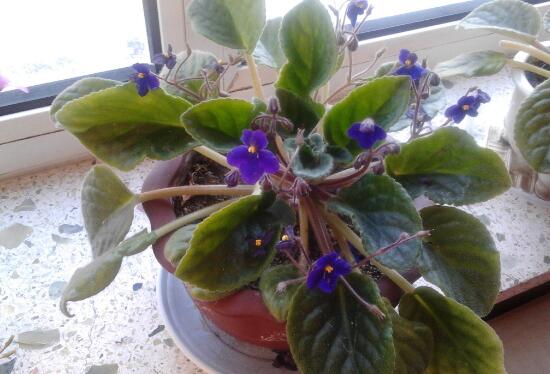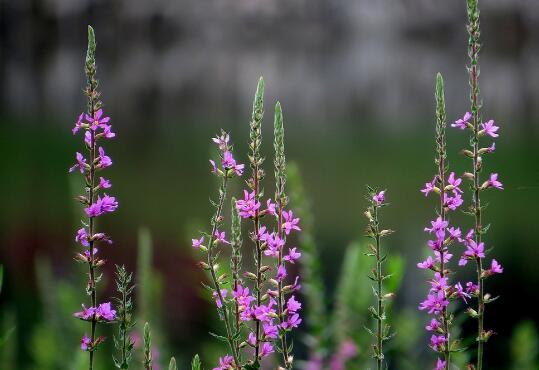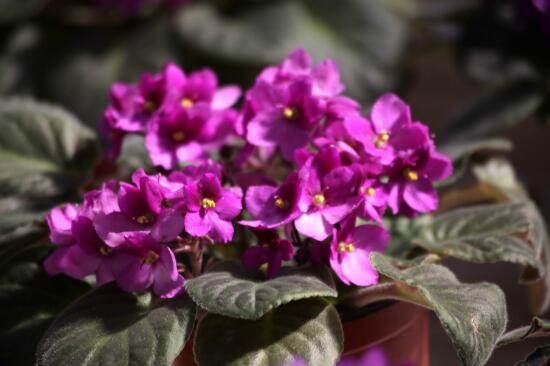How are African violets watered? how often are African violets watered / every 3-7 days?
When growing African violets indoors, watering is a favorite activity of flower lovers. If it was an old hand, it would be easy to say that it would water the plants in real time according to their growth state; but if it was a novice, it would be difficult to do it. There was no concept of how long African violets would be watered and how much water they would irrigate. So how do African violets water? The following is a detailed introduction by Xiaobian for everyone.
How to water African violets

African violets like wet environment, it is definitely like water, but it bogey water, so watering can not be more or less. Watering less, affecting plant growth; watering more, there will be yellow leaves of African violets, and even rotten roots. Therefore, how to water African violets, we must pay attention to the method, follow the principle of "not dry, not watered, watered thoroughly".
2. The watering method of African violet
(1)How long will African violets be watered?
On this issue, if it is a novice, keep watering once every 3-7 days, so that neither too often nor too little can ensure the normal growth of plants. Of course, after you water it, you should water it according to the state of the pot soil. When you find that the soil is dry, you should water it. Every time you water it, you should pay attention to watering thoroughly, that is, if you find excess water flowing out from the bottom of the pot.
(2)How to determine whether African violets should be watered
1, knock pot: determine whether African violet should be watered, the easiest way is to knock pot. Tap the flowerpot 1/3 place with your finger, the sound is clearer, indicating that the water in the flower soil is sufficient, and the sound is dull, indicating that the pot is dry, so you need watering at this time.
Weight: Flower friends who are sensitive to weight can hold flower pots and feel important before watering African violets. If it feels light, water it now. Of course, this weighing also requires a process, otherwise it is easy to make mistakes.
3, explore the soil: how to judge whether African violets should be watered, the most direct way is to explore the soil. Flower lovers can insert their fingers into 1/3 of the pot soil to feel it. Wet do not water, dry even fingers can not reach into, it should be watered!
(3)African violet watering method
Knowing how long African violets have been watered, how should they be watered? In this regard, we can use three methods: spraying, irrigation, bottom basin suction. Spray refers to watering with a watering can; irrigation means irrigation with a long mouth pot; bottom basin water absorption trouble point, water irrigation to the bottom water basin, wait a few minutes after the soil water absorption saturation, the remaining water will be poured out.
(4)Watering precautions
1, when the pot soil is found dry, can be watered, should try to avoid midsummer noon (higher than 35℃) or winter evening (lower than 15℃) watering.
2, watering temperature and plant as close as possible, so that it is conducive to plant absorption.
3, water for African violets, if it is tap water, must be exposed to the sun for 2-3 days, because there is chlorine in it, direct irrigation affects plant growth.
In general, watering is a technical activity, especially for African violets, we must grasp the timing and follow the watering principle of "not watering, watering is pouring", so that African violets can grow healthily. About the watering method of African violet, Xiaobian introduced this, the flower friend who raises it must water according to the method ~
How to raise African violets, African violet breeding methods and precautions
African violet, friends who have seen it should be impressed, its flower shape is small and exquisite, colorful, and it is very ornamental indoors. Life, because African violets long good-looking, many people want to raise it, then how to raise African violets? The following is a small series of carefully organized African violet breeding methods and precautions, very detailed, want to raise friends must see oh ~
How do African violets grow and understand their habits?
African violets like warm, humid and ventilated semi-shade environment, it is not resistant to high temperatures, afraid of strong light, so indoor African violets how to raise? We should put it in a good place to avoid direct sunlight, and in winter to do warm measures. As for the cultivation soil, it is best to have good aeration, water and fertilizer conservation soil.
II. Cultivation methods and precautions of African violet
1. Soil
How to raise African violets, first of all, you should re-select the pot soil. Nowadays, the potted plants of flower friends are basically purchased online, but the soil is very cheap, normal maintenance can ensure the growth of plants, but if you want the beauty of African violet flowers, it is best to choose soil again.
Soil selection: According to African violet's growth habits, it likes soil with good drainage and water and fertilizer conservation. In this regard, Xiaobian recommends that you use soil mixed with peat soil, vermiculite and pearl stone, or soil mixed with rotten leaf soil, peat soil and sand.
2. Light
Light is the key to plant growth, so light is indispensable in the cultivation of African violets. However, African violets are more tolerant of shade and prefer semi-shade environments, growing more under suitable scattered light. So when it is grown indoors, it is best to put it on the windowsill.
Note: African violet avoid strong light, in summer should be properly shaded, to avoid leaves being sunburned; in addition, we can not put it in the dark for a long time, otherwise it will affect the growth of plants, resulting in African violet does not bloom or excessive growth phenomenon.
3. Temperature
How to raise African violets, timely adjustment of temperature is also very important. It is understood that African violet likes warm environment, the most suitable growth temperature is about 16-24℃, of which April to October is 18-24℃, October to April of the next year is 12-16℃. Adjusting the temperature at all times can make African violets bloom more beautiful flowers.
Note: African violet is not resistant to high temperature, nor cold-resistant, in summer, the daytime temperature should not exceed 30℃, otherwise inhibit plant growth; winter temperature is not resistant to less than 10℃, otherwise it is easy to freeze.
4. Watering
Water is the source of life, so watering is an important part of the African violet culture method. African violet likes moist environment, moderate watering in spring, more watering in summer, temperature gradually decreasing in autumn and winter, watering appropriately reduced. When the weather is dry, the humidity of the surrounding air should also be increased by spraying water.
Note: African violet bogey ponding, watering plants, we can not water more, keep the pot soil slightly wet, otherwise it will cause stem rot; of course, watering can not be less, otherwise the plant pedicel will droop, but also shorten the flowering of African violet. In addition, avoid the leaves stained with water, once found should be wiped clean in time, otherwise it will also cause leaf decay.
5. Fertilization
After watering, let's talk about fertilization, which is also indispensable in the growth process of African violets. African violet likes fertilizer, growth period should be every 10-20 days to fertilize it once, fertilizer to nitrogen and phosphorus combined with thin decomposed liquid fertilizer or compound fertilizer is appropriate. Generally, the ratio of nitrogen fertilizer to phosphorus fertilizer to potassium fertilizer is 1:1:1.
Note: Fertilize African violet, preferably a small amount of multiple fertilization; enter the flowering period should be supplemented with phosphorus and potassium fertilizer, at this time do not apply too much nitrogen, otherwise there will be lush leaves and less flowering phenomenon.
6. Diseases and pests
In the process of breeding African violet, because of high air humidity, insufficient light, poor ventilation and other reasons, African violet is prone to blight, powdery mildew, leaf rot, scale insects and red spiders, which will seriously affect the ornamental nature of the plant. In this regard, we should prevent and control in time after discovery, which can refer to the pest control of African violet.
How to raise African violet in winter, African violet winter management method/multi-light warming
Growing plants indoors is most afraid of winter, and African violets are no exception at this point. Once the ambient temperature is too low, they will be frostbitten or even frozen to death. How do African violets grow in winter? In order for African violets to survive the winter safely, the following is a carefully organized winter management method for African violets. Let's take a look together!
How do African violets grow in winter?
African violets like warm semi-shade environment, winter night temperature can not be lower than 12℃, so how to raise African violets in winter? First, move African violets indoors to a place with good light, then keep the room temperature not lower than 12℃, and then water and fertilize appropriately. By doing this, your African violets are almost safe to winter.
II. Winter management of African violet
1. Temperature
In winter, the most important thing to care for African violets is temperature. It is understood that African violets love warmth and will stop growing when the temperature drops below 16℃. Although it can withstand a short period of 7-10℃ low temperature, but a long time, but also easy to die. So how to raise African violets in winter, the room temperature can not be lower than 12℃.
2. Light
African violet is a shade-tolerant plant, but it needs sufficient light, once long-term in too much shade, there will be less flowering, long leaves do not bloom phenomenon. Therefore, in winter, in order for African violets to receive sufficient light, they should be placed in a place with good light, such as a sunny windowsill.
3. Watering
In winter, although African violets grow slower, they are still growing, so watering should continue. However, in winter, the amount of watering should be reduced, and the watering interval should be controlled at 7-10 days. In addition, when watering, do not let the water touch the leaves, of course, it is best to master the watering method of African violets, so that it is not easy to make mistakes.
4. Humidity
African violets like humid environment, it is also very high requirements for moisture, in the air is relatively dry environment, is not conducive to growth. And in winter, it's very dry, so how do African violets grow in winter? We should increase the air humidity appropriately. Generally speaking, it is best to keep the air humidity between 40% and 70%.
5. Fertilizer
There is one thing to note about winter management of African violets, and that is fertilization. Don't go on! Although African violets require high levels of fertilizer, this is also associated with light. If it is winter, the light will not be very strong, and fertilization will not have any effect at this time. So, it seems that you can consider only applying base fertilizer, and do not consider applying topdressing.
- Prev

How to raise Qianchi, the breeding methods and precautions / sunshine should be sufficient.
It can be seen in Asia, Europe, Africa and other regions, but it is not easy to raise it well, and there are many places that need to pay attention to. About how to raise Chiqu vegetables? What are the culture methods and matters needing attention of Qianqu?
- Next

How to raise African violets in winter, management methods of African violets in winter / multi-light heating up
Growing plants indoors, the biggest fear is winter, and African violets are no exception. Once the ambient temperature is too low, it will be frostbitten or even frostbitten to death. So how to raise African violets in winter? For African violets to survive the winter safely.
Related
- Fuxing push coffee new agricultural production and marketing class: lack of small-scale processing plants
- Jujube rice field leisure farm deep ploughing Yilan for five years to create a space for organic food and play
- Nongyu Farm-A trial of organic papaya for brave women with advanced technology
- Four points for attention in the prevention and control of diseases and insect pests of edible fungi
- How to add nutrient solution to Edible Fungi
- Is there any good way to control edible fungus mites?
- Open Inoculation Technology of Edible Fungi
- Is there any clever way to use fertilizer for edible fungus in winter?
- What agents are used to kill the pathogens of edible fungi in the mushroom shed?
- Rapid drying of Edible Fungi

